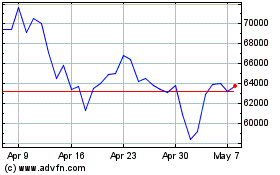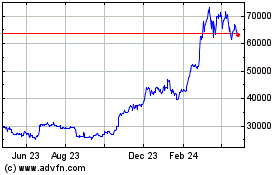100% Accurate Bitcoin Bottom Signal Hits: Time to Buy?
September 05 2024 - 10:00AM
NEWSBTC
Crypto analyst Astronomer, known by the handle @astronomer_zero on
X, has put forth a potentially compelling bottom signal for
Bitcoin, which hinges on the electricity costs incurred by miners
to produce BTC. According to him, this particular metric has
historically served as a reliable indicator for identifying optimal
buying opportunities within Bitcoin’s price cycles. Is The Bitcoin
Bottom In? The analysis titled “BTC Miners electricity cost, a 100%
accurate bottom signal,” leverages data to illustrate a scenario
where the cost of Bitcoin production dips below its market price,
suggesting a pivotal moment for potential investors. Astronomer
elaborated on his methodology and findings by referencing his
previous predictions which successfully pinpointed market tops,
notably a 30% drop from a $70,000 peak, which was guided by
similarly data-driven signals. Related Reading: Is Another Bitcoin
Crash Coming? Top Analyst Highlights Alarming Trend! Astronomer’s
current focus on the cost of mining stems from its significant
implications on Bitcoin’s supply dynamics. Despite the halving
events designed to reduce the reward for mining Bitcoin, there
remains a 0.84% annual inflation in its supply, equating to roughly
$10 billion worth of Bitcoin entering the market each year. This is
equivalent to the total holdings of significant corporate investors
like MicroStrategy, indicating a substantial influx of Bitcoin from
miners, who are inclined to sell gradually to sustain their
operations. However, the current market conditions, as described by
Astronomer, have reached a rare state where the market price of
Bitcoin has fallen below the average weighted cost of electricity
required to mine it. This situation typically constrains miners
from selling their holdings at a profit, thus potentially reducing
the sell pressure on the market. “Not only does that mean that the
miners can’t sell their BTC for a profit. It also means that it is
simply cheaper to just log into a CEX and buy 1 Bitcoin, instead of
going through the pain of mining 1 Bitcoin. So not only does this
make the miners (the people controlling BTC) not want to sell, it
also makes them want to buy, because it is cheaper to just buy
instead of mine them,” Astronomer suggests. Related Reading: $170
Million In Crypto Longs Bite The Dust As Bitcoin Plunges Under
$57,000 This shift not only impacts the selling behavior of miners
but also their buying strategies, contributing to a decrease in
supply pressure and possibly triggering upward price movements.
Astronomer supports his claim by pointing out that historically,
when the cost of production fell below the market price, it has
consistently led to substantial price recoveries. He detailed
instances from the recent past, including notable dips in March
2023 when Bitcoin hit $19,500, November 2022 at $16,500, June 2022
at $18,000, May 2020 at $8,900, March 2020 at $4,700, and November
2018 when it bottomed out at $3,500. Each of these moments was
followed by robust bull runs, underlining the potential reliability
of this signal. “How many times? 17 out of 17 times, it meant that
price was at levels that, according to history (with high
statistical significance), you would want to buy, or would miss and
regret it for a very long time,” the analyst adds. Currently, with
the production cost of Bitcoin, according to Capriole Investment’s
data, standing at $60,711 and the price lingering at $56,713, the
conditions described by Astronomer are manifesting yet again. This
juxtaposition poses a critical question to the market: Is now the
time to buy? While Astronomer’s analysis is backed by historical
data and detailed market observation, he remains cautiously
optimistic about the outcomes, encapsulated in his closing remark,
“Will this time be different? Maybe.” At press time, BTC traded at
$56,804. Featured image created with DALL.E, chart from
TradingView.com
Bitcoin (COIN:BTCUSD)
Historical Stock Chart
From Aug 2024 to Sep 2024

Bitcoin (COIN:BTCUSD)
Historical Stock Chart
From Sep 2023 to Sep 2024
